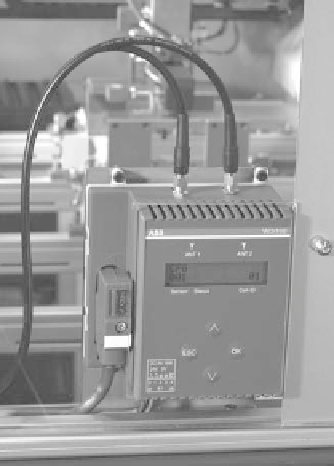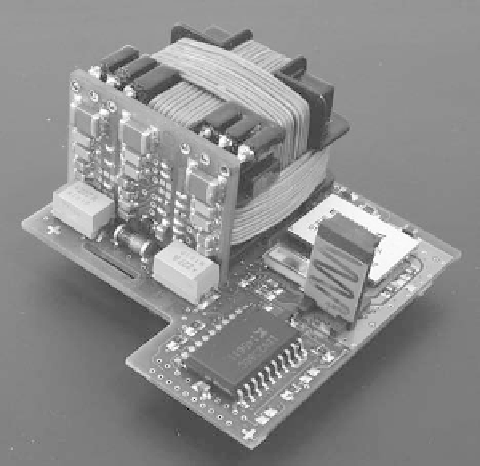Image Processing Reference
In-Depth Information
(a)
(b)
FIGURE .
WISA implementation: (a) WISA base station with antenna connectors and field bus plug (FBP)
connection to controller. (b) WISA sensor module with receiver coil for wireless power supply and communication
transceiver, controller, and antenna. (From Scheible, G., Dzung, D., Endresen, J., and Frey, J.-E.,
IEEE Ind. Electron.
Mag
., , , . With permission.)
the fieldbus connecting it to the automation controller. Diagnostics and configuration features are
supported.
Due to the communication protocol requirements, a standard RF front-end cannot be used for
the base station implementation. he requirements differ significantly from those found in WLANs
and Bluetooth in that the BS must operate in full duplex mode. he BS must simultaneously receive
signals from up to four SAs with a dynamic range of more than dB.
In contrast to the BS, the WISA node may use existing RF transceiver hardware (IEEE ..
based). A WISA sensor module is shown in Figure . (in this implementation a proximity
switch []), with the power receiving coil, an IEEE .. based transceiver, and a microcon-
troller and an FPGA for the WISA protocol. For low power consumption, the transceivers “sleep”
until an event occurs. he communication antenna on the module has an omnidirectional radiation
characteristic in order not to have to line up the device at installation.
28.4.1 Coexistence
Wireless coexistence is a practical and increasing concern in industrial automation applications.
Many different applications may use wireless systems, which may compete for the same frequency
band with different technologies. he limited resource are the radio frequencies, and for WISA that
is in the ISM Band from .-. GHz.
The situation may be compared with highways, which have a limited width and many different
types of vehicles fulfilling different transport tasks. For each of the transport tasks, different require-
ments apply; the capabilities of the vehicles are quite different also. In addition, certain rules apply to
avoid dangerous situations (e.g., speed limits).
In today's factories coexistence or frequency management has to be established to coordinate
the use, as the frequency bands are a valuable resource. In a larger factory, generally every system



